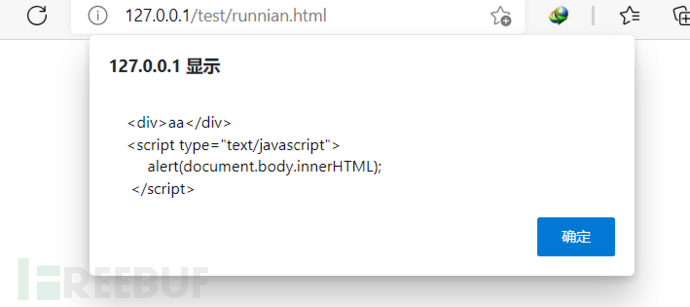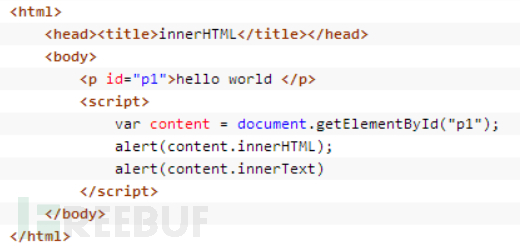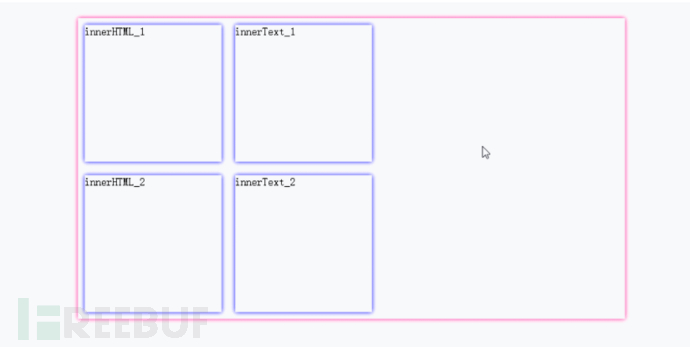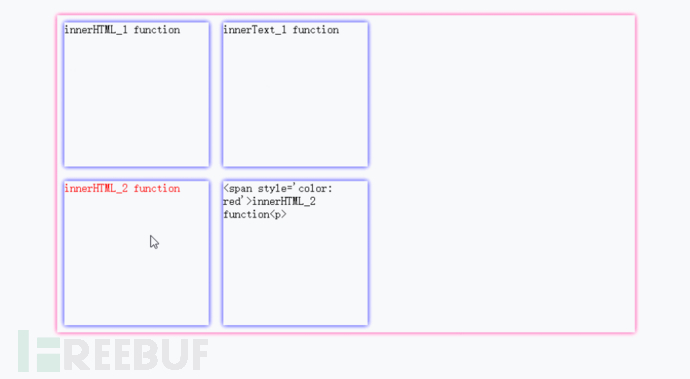document对象中有innerHTML、innerText这两个属性,都是获取document对象文本内容,但使用起来还是有区别的;
区别
1) innerHTML设置或获取标签所包含的HTML+文本信息(从标签起始位置到终止位置全部内容,包括HTML标签,但不包括自身)
2) outerHTML设置或获取标签自身及其所包含的HTML+文本信息(包括自身)
3) innerText设置或获取标签所包含的文本信息(从标签起始位置到终止位置的内容,去除HTML标签,但不包括自身)
4) outerText设置或获取标签自身及其所包含的文本信息(包括自身) innerText和outerText在获取的时候是相同效果,但在设置时,innerText仅设置标签所包含的文本,而outerText设置包含包括标签自身在内的文本。
innerText和outerText在获取的时候是相同效果,但在设置时,innerText仅设置标签所包含的文本,而outerText设置包含包括标签自身在内的文本。
例子1:outerHTML和innerHTML的区别
document.body.outerHTML:
<!DOCTYPE html> <html> <head> </head> <body> <div>aa</div> <script type="text/javascript"> alert(document.body.outerHTML); </script> </body> </html> 结果:
document.body.innerHTML:
<!DOCTYPE html> <html> <head> </head> <body> <div>aa</div> <script type="text/javascript"> alert(document.body.innerHTML); </script> </body> </html> 结果:
通过不同的结果可以得出:outerHTML属性比innerHTML属性多包含了<body>标签
还有需要注意的是:
innerHTML是所有浏览器都支持的属性。outerHTML属性不是DHTML标准,IE外的其它浏览器不支持。
在非IE浏览器下必须使用扩展方法才能获取,扩展方法如下:
if(typeof(HTMLElement)!="undefined" && !window.opera) { var pro = window.HTMLElement.prototype; pro.__defineGetter__("outerHTML", function(){ var str = "<" + this.tagName; var a = this.attributes; for(var i = 0, len = a.length; i < len; i++) { if(a[i].specified) { str += " " + a[i].name + '="' + a[i].value + '"'; } } if(!this.canHaveChildren) { return str + " />"; } return str + ">" + this.innerHTML + "</" + this.tagName + ">"; }); pro.__defineSetter__("outerHTML", function(s){ var r = this.ownerDocument.createRange(); r.setStartBefore(this); var df = r.createContextualFragment(s); this.parentNode.replaceChild(df, this); return s; }); } innerHTML和innerText的区别
innerText和outerText在获取的时候是相同效果,但在设置时,innerText仅设置标签所包含的文本,而outerText设置包含包括标签自身在内的文本。
示例代码: 通过IE浏览器打开,弹出内容为
通过IE浏览器打开,弹出内容为hello world和hello world
通过Firefox浏览器打开,弹出内容为hello world和undefined
通过chrome浏览器打开,弹出的内容为hello world和hello world
alert(content.outerHTML)则弹出:<p id="p1">hello world</p>
示例2: 通过IE浏览器打开,弹出内容为
通过IE浏览器打开,弹出内容为<p id="p1">hello world</p>和hello world
hello world
“和"hello world”
hello world
“和"hello world”
通过Firefox浏览器打开,弹出内容为<p id="p1">hello world</p>和undefined
hello world
“和"undefined”
hello world
“和"undefined”
通过chrome浏览器打开,弹出的内容为<p id="p1">hello world</p>和hello world
hello world
“和"hello world”
hello world
“和"hello world”
alert(content.outerHTML)则弹出:<div id="d1"><p id="p1">hello world</p></div>
hello world
"
hello world
"
综上:
innerHTML所有浏览器都支持,innerText是IE浏览器支持的,Firefox浏览器不支持。
不同之处:
1) innerHTML、outerHTML在设置标签之间的内容时,包含的HTML会被解析;而innerText、outerText则不会;
2) innerHTML、innerText仅设置标签之间的文本,而outerHTML、outerText设置包含自身标签在内文本
总结
innerHTML是符合W3C标准的属性,而innerText只适用于IE浏览器(现在也适应chrome浏览器),因此,
尽可能地去使用
innerHTML,而少用innerText,如果要输出不含HTML标签的内容,可以使用innerHTML取得包含HTML标签的内容后,再用正则表达式去除HTML标签。
<!DOCTYPE html> <html lang="en"> <head> <meta charset="UTF-8"> <title>Title</title> <meta charset="UTF-8"><!--申明当前网页的编码集UTF-8--> <meta name="Generator" content="EditPlus®"> <!--编辑器的名称--> <meta name="Author" content="作者是谁"> <meta name="Keywords" content="关键词"> <meta name="Description" content="描述和简介"> <style type="text/css"> body,dl,dd,dt,p,h1,h2,h3,h4,h5,h6{ margin: 0;} ul,ol{margin: 0; list-style: none; padding: 0;} a{ text-decoration: none; } *{ margin: 0; padding: 0; } .fl_l{float: left} .clearfix:after{clear: both;content: "";display: block} .main{width: 800px;margin: 40px auto;box-shadow: 0 0 10px 0 deeppink} p{width: 200px;height: 200px;box-shadow: 0 0 10px 0 blue;margin: 10px} </style> </head> <body> <div class="main"> <div class="compare1 clearfix" > <p class="fl_l" id="innerHTML_1">innerHTML_1</p> <p class="fl_l" id="innerText_1">innerText_1</p> </div> <div class="compare2 clearfix"> <p class="fl_l" id="innerHTML_2">innerHTML_2</p> <p class="fl_l" id="innerText_2">innerText_2</p> </div> </div> <script> var innerHTML_1 = document.getElementById("innerHTML_1"); var innerText_1 = document.getElementById("innerText_1"); var innerHTML_2 = document.getElementById("innerHTML_2"); var innerText_2 = document.getElementById("innerText_2"); innerHTML_1.onmouseover = function () { this.innerHTML = "innerHTML_1 function"; } innerText_1.onmouseover = function () { this.innerText = "innerText_1 function"; } innerHTML_2.onmouseover =function () { this.innerHTML = "<span style='color: red'>innerHTML_2 function<span>"; } innerText_2.onmouseover = function () { this.innerText = "<span style='color: red'>innerHTML_2 function<p>"; } </script> </body> </html> 
 从上面可以看到,如果从纯文本的角度来理解的话,innerHTML和innerText都是一样的,因为在添加字符串这样数据的时候,是没有任何区别的,
从上面可以看到,如果从纯文本的角度来理解的话,innerHTML和innerText都是一样的,因为在添加字符串这样数据的时候,是没有任何区别的,
但是如果从标签的角度来进行加载的话,innerHTML是可以去进行标签的解析的,也就是可以动态的再去加载标签,但是innerText确是以文本的形式进行显示的
这也就是它们主要的区别,虽然都是可以在标签中添加内容,但是不同的应用场景下,使用的标签页也是需要不同的
hello world
"
hello world
"
的角度来理解的话,innerHTML和innerText都是一样的,因为在添加字符串这样数据的时候,是没有任何区别的,
但是如果从标签的角度来进行加载的话,innerHTML是可以去进行标签的解析的,也就是可以动态的再去加载标签,但是innerText确是以文本的形式进行显示的
这也就是它们主要的区别,虽然都是可以在标签中添加内容,但是不同的应用场景下,使用的标签页也是需要不同的
hello world
"
hello world
"
学习计划安排

我一共划分了六个阶段,但并不是说你得学完全部才能上手工作,对于一些初级岗位,学到第三四个阶段就足矣~
这里我整合并且整理成了一份【282G】的网络安全从零基础入门到进阶资料包,需要的小伙伴可以扫描下方CSDN官方合作二维码免费领取哦,无偿分享!!!
如果你对网络安全入门感兴趣,那么你需要的话可以
点击这里👉网络安全重磅福利:入门&进阶全套282G学习资源包免费分享!
①网络安全学习路线
②上百份渗透测试电子书
③安全攻防357页笔记
④50份安全攻防面试指南
⑤安全红队渗透工具包
⑥HW护网行动经验总结
⑦100个漏洞实战案例
⑧安全大厂内部视频资源
⑨历年CTF夺旗赛题解析

